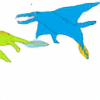HOME | DD
 ForbiddenParadise64 — Ao-Oni teaser
ForbiddenParadise64 — Ao-Oni teaser

Published: 2014-11-14 18:35:58 +0000 UTC; Views: 1116; Favourites: 15; Downloads: 0
Redirect to original
Description
It has been a staggering 400 million years since the Tyrant destruction and the establishment of the heavily genetically modified Oni as the sole vertebrate heir to a virgin planet. Many millions of years have passed, climates got warmer and cooler, mountains rose and fell, even mass extinctions have occurred-at least 3. This remarkable creature radiated in a staggering way, in which no group of vertebrates before had ever done. The oceans are now home to many different descendents of humans, in many different waves. Here we shall look at the oceanic fauna of the Mandalorian Ocean.Throughout the mesozoic and cenozoic, several waves of reptiles, mammals and birds made their way into the sea, and this one is definitely no exception either. The first wave appeared in the oceans more than 300 million years ago, using their finger derived limbs as paddles, developing them into anomilacarid like bodies. This group are the Scuttlebeasts (xenothalassiotheres) occupy a wide range of niche, particulary many that would be held by larger cephalopods and sharks, roaming hte waters in search of prey like dolphins, using their primitive thumb claws as a way to stap prey and allow their jaws to ruthlessly dismember it as it is held. Their motion allows them to mediate between slow graceful swimming and rapid bursts of speed. Being one of the most basal groups, they are partially ectothermic, which means they are much more limited to tropical regions than other more recent groups. This is partially due to the sheer specialisations that they ahve made. possibly the most remarkable of all their marine adaptions is their ability to convert water into oxygen via the location of the former mammary glands, working effectively as pseudogills, allowing species to potentially spend their entire lives underwater. Only certain lethargic species can do this however due to hte faster lifestyles they tend to have. Even without this water-breathing ability, many species are able to hold their breath for over 3 hours due to their advanced lung structure. The species shown-the common jet-beast ( is a medium-large species, measuring about 3m long excluding the mostly ornamental tail, and closely resembles a Cambrian anomilacarid. In the absence of fish, several groups of animals have taken up the role in the ecosystem of main food-giver for these human descendents. Depending on the region, these niches can be taken up by neotonous shrimps, crabs, pellagic gastropods and even swimming worms. In htis case all three groups are shown, as the members occupy different niches which mean they don't compete. Large jellyfish are also able to thrive in these rich oceans, and filter the plankton in the currents.
The xenothallassiotheres are certainly not as prevalent as they used to be. They have been able to survive various mass extinctions, and have often diversified in their aftermath, but increasingly other groups have arrived on the scene to offer them competition. In the past, the xenothallasiotheres have been with such creatures and managed to outlive them. But each time they did, their grip on power slowly loosened. At no time has this been more apparent than the last 98 million years, following the devastation of the End-Macrozoic Impact. In the aftermath of this, a possibly even more bizarre group of animals has managed to dip their toes into the water and become cosmopolitan. These creatures have had a far greater amount of time to evolve on land, and so when they arrive in the water, they are already an established evolutionary line. These animals are the allocetids, a group of marine intracephaloids, some of hte most bizarre of all the creatures on this planet. They get the name from the fact their heads are upside down due to a genetic fault, meaning their eyes, ears and nostrils are on what would be the 'lower jaw' which is in fact the upper jaw, while hte lower jaws are at the top. This would appear to be some kind of serious defect for many organisms, except for this clade, it proved beneficial in several ways, allowing them to be more effective at locating smaller animals, while honing their other senses to detect predators. Their thumbs have also split apart resulting in a new set of fingers, meaning the old digits are so far derived they have become limbs in their own right. In the aftermath of the Mumbian Mass Extinction, some cephalanopods made their way into the oceans, gradually evolving into the ancestors of the allocetids, which have slowly overtaken the xenothallassiotheres as the dominant marine vertebrates, at least in many regions of the ocean. They are endothermic fully and can thus survive in polar waters with relative ease as well. The bodies resemble those of fish and whales and so they seem more familiar. The teeth of these particular forms, or typhoons, have become fine and thin, allowing them to sieve plankton and shrimp larvae from the water effectively, becoming similar in niche to baleen whales. This example of diversity is but a small fraction of that which exists in Ao-Oni, and thus it is necessary for us to explain this strange ecosystem in ever greater detail.
Related content
Comments: 3

Since you want to submit this to the future evolution folder, could you describe, for example, what are those four jaw crocodile like creatures evolved from?
👍: 0 ⏩: 2

It's actually 3 jaws-the lower jaw was split in two, somewhat similar to that of a snake. The animal pictured is a very distant descendent of the Oni featured here forbiddenparadise64.deviantart… this pic was done as a teaser for things upcoming. I shall add descriptions for them.
👍: 0 ⏩: 0

They are extremely derived posthumans, which are descended from a genetically engineered ancestor which walked on its fingers.
👍: 0 ⏩: 0

















